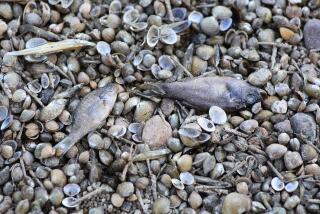Developer to Pay $95,000 for Bulldozing River : Court settlement: Newhall Land & Farming agrees to replant two endangered species’ habitat on the Santa Clara.
A major landowner in northeast Ventura County has agreed to pay $95,000 in penalties for bulldozing the Santa Clara River and two tributaries and disturbing the habitat of two endangered species.
Newhall Land & Farming Co. admitted the civil violations in Ventura County Superior Court this week after lengthy negotiations, Deputy Dist. Atty. Michael D. Schwartz said Friday. As part of the settlement signed by Judge Steven Z. Perren, Newhall agreed to a permanent injunction that prohibits the company from unlawfully altering stream beds in the future and requires Newhall to replant the destroyed habitat.
It was the second such agreement involving Newhall in the past 14 months. In September, 1991, the Valencia Co.--a Newhall division that is the largest developer in the Santa Clarita Valley--pleaded no contest to a criminal complaint that it illegally altered the Santa Clara stream bed east of Interstate 5.
Newhall was ordered to pay $94,500 in penalties and as much as $300,000 for plant restoration in that earlier case, which involved grading for two developments.
The Santa Clara, which flows from Acton in Los Angeles County to the Pacific Ocean between Oxnard and Ventura, is one of the few mostly natural river basins in Southern California.
Unlike the Los Angeles and San Gabriel rivers, which are almost entirely lined with concrete, the 100-mile-long Santa Clara’s banks are concrete-lined only in Santa Clarita and to the east, for a total of about six miles. The Santa Clara provides habitat for two endangered species: a songbird known as the least Bell’s vireo and a fish called the unarmored threespine stickleback.
Newhall owns 22,000 acres along the river in Los Angeles County and 15,000 acres in Ventura County.
The first of the company’s violations in Ventura County occurred in February, 1990, Schwartz said. A state Department of Fish and Game warden, flying over a Ventura County portion of the river, noticed a bulldozer clearing debris from the riverbed, Schwartz said.
Another violation was observed in January, 1991, when a warden flying over Tapo Canyon Creek--a tributary of the river--saw a bulldozer clearing the stream bed, the prosecutor said. The third violation involved similar work on an unnamed creek that flows into the river, Schwartz said.
In all three cases, he said, the company failed to obtain permits from the state wildlife agency and from the Army Corps of Engineers.
Newhall’s attorney, Glen M. Reiser, said company officials were clearing the stream beds of debris to protect farmland from flooding and did not realize they were violating fish and game department regulations.
“Channeling work on the Santa Clara River had been done by Newhall since the turn of the century,” he said. “They were doing what they always had done.”
Since the agency raised its objections, he said, Newhall has been involved in negotiations to obtain permits for such work. Last winter, the Santa Clara riverbed was not cleared before spring floods, Reiser said, “and we had a lot of flood damage.” The company mostly grows oranges on the western side of its holdings and grain crops on the colder eastern side, he said.
Friday was a state holiday and fish and game department officials were not available for comment.
Bobbe Dorsey, a board member of the Ventura Audubon Society, called the settlement “a stride forward.”
“Maybe we’re going into a new era where all the law is being better enforced,” she said. “I’m very hopeful.”
Mark Capelli, a biologist who teaches at UC Santa Barbara, said Newhall should expect land along the river to be flooded from time to time. “I don’t know why someone would expect land in a river bottom not to be flooded,” he said. “It goes with the territory. They knew that when they bought it.”
As for the argument that Newhall has been clearing parts of the river for decades, Capelli said: “A century ago, the least Bell’s vireo was not endangered. You used to be able to burn trash privately. That’s illegal now. . . . There’s a lot of things you don’t do today that you could do 20 to 30 years ago.”
Biologists estimate that only about 500 nesting pairs of the least Bell’s vireo remain in the United States. The number of unarmored threespine stickleback varies according to stream flow. Some experts believe the fish is now found only in the Santa Clara, having disappeared from the Los Angeles and San Gabriel rivers.
The fish thrive in a river that flows only during the rainy season and cannot survive in fast-moving, silty water.
In recent years, state and local officials have become more aggressive about protecting the Santa Clara.
In addition to the court actions involving Newhall, the Ventura County district attorney’s office filed a lawsuit earlier this month against a Fillmore citrus company that allegedly bulldozed about half a mile of riverbed near the firm’s groves in 1989.
State and federal officials, meanwhile, are trying to develop a comprehensive management plan for the river. The plan is aimed at reconciling the various activities in the river valley, which include oil pipelines, housing developments and gravel mines as well as agriculture.
More to Read
Sign up for Essential California
The most important California stories and recommendations in your inbox every morning.
You may occasionally receive promotional content from the Los Angeles Times.










